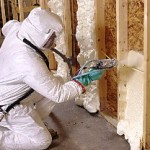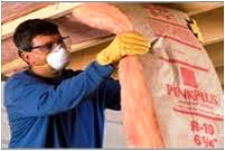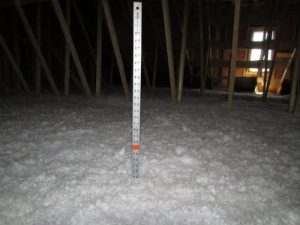 Recently I read a thread in a discussion group where a person posting was not going to use closed cell spray foam insulation in their pole barn due to safety precautions needed when installing. This got me wondering just how safe or unsafe installing fiberglass insulation is, so I started doing research.
Recently I read a thread in a discussion group where a person posting was not going to use closed cell spray foam insulation in their pole barn due to safety precautions needed when installing. This got me wondering just how safe or unsafe installing fiberglass insulation is, so I started doing research.
Fiberglass insulation, also sometimes known as glass wool, is made of tiny fibers of spun glass. As with any type of glass, threads making up fiberglass can break, leaving sharp edges. Contact with fiberglass fibers can cause miniscule cuts as well torturous itching. Best way to avoids cuts and itches is to wear proper protective gear when working with such insulation.
Wear a hat or hood when working with fiberglass to keep those itchy little fibers from getting into your hair. This is especially important if you are insulating very tall walls or ceilings. Any kind of hat will do as long as it sits firmly on your head and does not impair your vision in any way.
 Goggles and a dust mask are crucial safety equipment because those tiny glass fibers can irritate your eyes and lungs. Choose large safety goggles fitting securely all around your eyes, including sides. You do not need a heavy-duty filtration mask when working with fiberglass. A simple dust mask available at any hardware or home improvement store should provide an adequate barrier to keep fiberglass particles from being inhaled.
Goggles and a dust mask are crucial safety equipment because those tiny glass fibers can irritate your eyes and lungs. Choose large safety goggles fitting securely all around your eyes, including sides. You do not need a heavy-duty filtration mask when working with fiberglass. A simple dust mask available at any hardware or home improvement store should provide an adequate barrier to keep fiberglass particles from being inhaled.
Wear a disposable coverall to help protect your clothing because once glass fibers become embedded in fabric, it’s almost impossible to get them back out. Wear long sleeves and long pants underneath your coverall for extra protection. It is not necessary to tape coverall wrists and ankles.
Wear gloves when handling fiberglass. Open-weave knit gloves will not provide enough protections from tiny glass fibers, so wear gardening gloves or lightweight work gloves to protect your hands. Whether or not you wear gloves when working with fiberglass, wash your hands thoroughly even if you are only taking a short break. This will help you keep from inadvertently spreading fiberglass fibers to your face, hair or anything else you may touch.
Back in my Lucas Plywood & Lumber days, I shared an office with Al Mercer, who ran their insulation installation department. One trick I learned from one of his old time installers – apply baby powder or cornstarch before placing fiberglass insulation, on any skin apt to be exposed. These will fill skin pores and prevent itching.
 Thanks again for the input. I read those articles you mentioned on the BIBs and the white liner panels. The liner panels are very common and popular around here but the article had very good points and gave me more to think about. As for the insulation, I was not familiar with the BIBs system and was impressed. I have done some more reading and reached out to a few contractors for quotes on the BIBs system. I do prefer to do things myself whenever possible however, so the option of installing fiberglass myself is still on the table. This is where I still have a question. You mentioned to fill the entire wall cavity with unfaced fiberglass and then cover with Visqueen. Is there an issue if the cavity is not completely filled and an air space is created between the fiberglass and the Tyvek® behind the metal sheeting? I ask because my walls are roughly 5 1/2” deep and obviously R13 is only 3 1/2” thick and R19 is 6 1/2” thick. If I go with R13 (cheaper) I end up with an air space. If I go with R19, I end up compressing it and losing r value anyway. Also, I have diagonal bracing in the corners which will also make it near impossible to tightly fill with fiberglass batts. I would love to go with the BIBs system but am waiting to see if it is within budget. If I can save considerable money insulating myself with batts I would most likely do so but need to be sure I am not causing problems down the road. Sorry for being so long winded and thank you very much for all your help and information.”
Thanks again for the input. I read those articles you mentioned on the BIBs and the white liner panels. The liner panels are very common and popular around here but the article had very good points and gave me more to think about. As for the insulation, I was not familiar with the BIBs system and was impressed. I have done some more reading and reached out to a few contractors for quotes on the BIBs system. I do prefer to do things myself whenever possible however, so the option of installing fiberglass myself is still on the table. This is where I still have a question. You mentioned to fill the entire wall cavity with unfaced fiberglass and then cover with Visqueen. Is there an issue if the cavity is not completely filled and an air space is created between the fiberglass and the Tyvek® behind the metal sheeting? I ask because my walls are roughly 5 1/2” deep and obviously R13 is only 3 1/2” thick and R19 is 6 1/2” thick. If I go with R13 (cheaper) I end up with an air space. If I go with R19, I end up compressing it and losing r value anyway. Also, I have diagonal bracing in the corners which will also make it near impossible to tightly fill with fiberglass batts. I would love to go with the BIBs system but am waiting to see if it is within budget. If I can save considerable money insulating myself with batts I would most likely do so but need to be sure I am not causing problems down the road. Sorry for being so long winded and thank you very much for all your help and information.”





